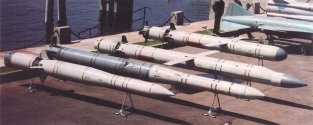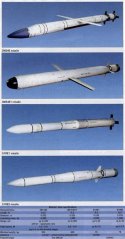YJ-18 should have secondary land attack capabilities. While that is not optimal usage of YJ-18, it might be sufficient for what PLAN needs right now.
As I posted in the hypersonic development thread, I see basically 3 phases to Chinese AShM in the past 15 years.
1) the proliferation of long range high subsonic missiles like YJ-83s and YJ-62s. They were able to loading up those Type 022s with 8 YJ-83s each. Pretty intense stuff. In reality, I'm not sure how much damage they can put on a USN carrier group even if all the Type 022s launched 8 missiles each. Maybe a few escort, but I doubt they'd be able to put a carrier out of action.
2) the proliferation of long range high supersonic missiles like YJ-12 and YJ-18 on both bombers and surface warships. This is actually much more dynamic threat, since YJ-18 combines all the benefits of supersonic and subsonic missiles (long range, low profile and high supersonic terminal phase). Being able to carry them in UVLS means PLAN can launch saturation attacks with a whole bunch of supersonic missiles. This would trouble a carrier group a lot more, but I'm still not sure if they'd be able to put a carrier out of action.
3) the likely proliferation of air and sea launched ASBM and hypersonic anti-ship missiles. I expect them to continue developing these missiles to be ever harder to pick up and intercept. I think having multiple ASBM, HGV and HCM come at a carrier is a couple of magnitude more difficult to cleanly intercept than similar number of subsonic AShM. Just thinking about having a mach 5 missile coming straight down vs sea-skimmers flying parallel to target in subsonic speed. It is really hard to cleanly intercept the former without any debris causing damages. A clean hit might be able to even sink a carrier. Even if several subsonic cruise missiles hit a modern supercarrier, I don't think it would sink it.
You see a progression of PLAN anti-ship missiles getting progressively harder to intercept. And this happened in a short time. I'm not sure what the next step is except maybe flying even faster in terminal stage and becoming more maneuverable to invade defense and maybe flying profiles that would be harder to pick up and predict.
This discussion about a "land attack YJ-18" is not referring to the standard "YJ-18" having a secondary land attack capability.
The "land attack YJ-18" is instead talking about a very different missile variant but sharing a few subsystems with YJ-18, that has a similar role to Tomahawk and the Russian Kalibr.
We all remember how in the early 2010s, we were expecting a new universal VLS to come out for the next gen of PLAN surface combatants, which would be able to carry SAMs, AShMs, and land attack cruise missiles (like Tomahawk), among other weapons like VLA etc.
Well, that VLS emerged -- the UVLS that was first installed on 052D, and then 055.
In the case of the LACM for the UVLS, initially people expected a variant of the DF-10/KD-20 cruise missile (which is the GLCM and ALCM respectively) to be launched from the UVLS.
But then sometime in the mid to late 2010s, the rumours changed and it turned out that actually the LACM for the PLAN's UVLS would be an YJ-18 variant! At first this seems odd, but then if we realize that the DF-10/KD-20 missile is probably a bit too big for the UVLS, and then if we trace back the YJ-18 heritage, it makes some sense.
In terms of YJ-18's heritage, the standard AShM variant of course is derived from the Russian Klub missile (3M54E). However, the Klub missile itself is part of a family of missiles with shared key subsystems -- and one major variant of that family is the 3M54E1/3M14E -- a subsonic Tomahawk equivalent missile (3M54E1 being the anti ship subsonic missile, 3M14E being the subsonic LACM, both with the same airframe). This missile is now better known as the Kalibr missile that the Russian navy operates as its Tomahawk equivalent.
For the PLAN, the rumours for the last 5-6 years have basically been strongly hinting that the PLAN's subsonic LACM (Tomahawk equivalent) is a "YJ-18 variant" in the same way that the Kalibr is a "Klub variant".
This YJ-18 variant has been dubbed "YJ-18C" in the past, but I am unsure if that is its definitive name
Here are some pictures showcasing the size difference between Klub/3M54E and Kalibr/3M14E -- and we can use these images to extrapolate the situation for the YJ-18 and "YJ-18C"/"land attack YJ-18 variant" as well
Top shows Kalibr/3M14E, Bottom shows Klub/3M54E.
Note how the subsonic Kalibr is much shorter than the subsonic/supersonic capable Klub.

Another perspective showing full size models -- of these four grey missiles, the one at the topmost (right most) is the Kalibr/3M14E and immediately below it is the Klub/3M54E.

This is a promo spec sheet depicting the various weapons of the Klub family, including Klub/3M54E at the top, and the Kalibr/3M54E1 (which is the same airframe as the 3M14E) right below it, with a list of dimensions at the bottom.
Keep in mind the performance numbers are all export and thus MTCR compliant (ranges below 300km).

